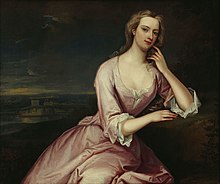Henrietta Howard, Countess of Suffolk
| Henrietta Howard | |
|---|---|

Henrietta Howard, Countess of Suffolk, c.1724, by Charles Jervas.
|
|
| Born | 1689 |
| Died | 1767 (aged 77–78) |
| Spouse(s) |
Charles Howard, 9th Earl of Suffolk George Berkeley |
| Children | Henry Howard, 10th Earl of Suffolk |
| Parents |
|
Henrietta Howard (1689 – 26 July 1767) was a mistress of King George II of Great Britain.
She was the daughter of Sir Henry Hobart, 4th Baronet, a Norfolk landowner who died in a duel when Henrietta was aged eight. Her mother Elizabeth (née Maynard) died a few years later.
Having become the ward of the Earl of Suffolk, she married his youngest son, Charles Howard, at the church of St Benet, Paul's Wharf in London on 2 March 1706, hoping to provide for her siblings. They had one son, Henry Howard, 10th Earl of Suffolk. The marriage was unhappy; Charles was a wife-beater and compulsive gambler.
In 1714, they travelled to Hanover, hoping to ingratiate themselves with the future George I of Great Britain. Henrietta met and became mistress to his son, the future George II, and was appointed a Lady of the Bedchamber to his wife, Caroline of Ansbach. In 1723, the prince made a financial settlement with her husband in exchange for her services as a royal mistress. Queen Caroline liked Henrietta, and was happy that the King kept a mistress she found congenial, although she would occasionally administer snubs to Henrietta in public. Henrietta was noted for wit and intelligence (she went deaf at an early age) rather than beauty.
She and her husband officially separated, and after Charles Howard's death in 1733, Henrietta remarried, in 1735, the Hon. George Berkeley, son of the Earl of Berkeley.
After leaving the position of mistress to George II, Henrietta purchased land on the banks of the River Thames, having received a very large financial settlement from him. Marble Hill House in Twickenham was built for her on this site by the architect Roger Morris, who collaborated in its design with Henry Herbert, 9th Earl of Pembroke, one of the "architect earls." When her second husband died, in 1746, she retired there permanently. She formed an intellectual circle, and her many friends included Charles Mordaunt, 3rd Earl of Peterborough, and Alexander Pope, who wrote of her, in his poem "On a certain lady at court":
...
Wikipedia
